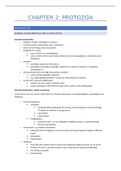CHAPTER 2: PROTOZOA
INTRODUCTION
GENERAL CHARACTERISTICS AND CLASSIFICATION
General characteristics
o Kingdom: protista, subkingdom: protozoa
o Can live in plants, invertebrates and vertebrates
o Some are free-living, some are parasites
o Subdivided in 7 phyla
many of them are not pathogenic
only 3 of them with human medical importance: sacromatogophora, apicomplexa and
ciliophoran
o structure:
unicellular eukaryote cell structure
specialized intracellular organelles: important for uptake of nutrients, metabolism,
locomotion etc.
o short generation time and high reproduction potential
result: quickly adaptable organisms
e.g. rapidly getting resistance need for monitoring the resistance
o sexual and/or asexual multiplication
asexual: very fast, used to colonize a host
sexual: exchange of DNA material to get some variance in the DNA genome
General classification: 3 phyla of protozoa
In this course, we focus on the 3 phyla that are of human importance: sarcomastogophora, apicomplexa and
ciliophora.
o Sacromastogophora:
Sarcodina:
amoeboid with pseudopodia for moving and food uptake in a certain lifestage
uptake of nutrients via phagocytosis
extracellular
heterotrophe
Mastigophora:
Eukaryotes with 1 or more flagellae in flagellar pocket in a certain lifestage
Most are extracellular
o Apicomplexa: e.g. malaria, toxoplasma
Eukaryotes with no flagellae (cannot move) but with apical organel complex in different
stages
Intracellular
heterotrophe
o Ciliophora:
Oval cells with ciliated surface (smaller than flagella but higher amounts so can move)
Presence of macro- and micronucleus, micro: important for sexual recombination
Free-living or parasitic
Heterotrophe
,SPECIFIC CHARACTERISTICS OF PROTOZOA
Explanation of the terminology
Endogeny: daughter cells inside mother cell before cell division (e.g. toxoplasma)
Schizogony: first multiple nuclear divisions followed by cytoplasmic incision, different processes
- merogony: give rise to merocytes which is a perfect target for drug treatment
- sporogony: give rise to sporozoites, proliferating/infectious stage of a parasite in a vector
- gametogony: give rise to gametocytes -> gametes, not a drug target
Cyst: protective stage of a parasite, can survive in certain conditions it which it otherwise won’t survive
,DETAILED CLASSIFICATION OF PROTOZOA
*only those indicated in blue are important to remember
- hemoflagellates: trypanosoma and leishmania
- mucoflagellates: trichomonas
commensal, found in mucosa of GIT
Groups at risk for infections
- toxoplasma: risk during pregnancy
- isospora, cryptosporidium: risk for HIV patients
- plasmodium: risk for children (plasmodium falciparul, celebral malaria)
- babesia: risk for dogs, immunocomprimied people (no spleen)
Treatment of infections
- mucoflagellates: nitroimidazoles – induce ROS, cause DNA damage in the parasite
- hemoflagellates: different options depending on the location of the parasite
if infection also in the brain: drug needs to able to cross the blood-brain barrier without being toxic
INTESTINAL AMOEBAE
Most entamoeba are located in the large intestine and will remain there, therefore the pathogenicity of these
parasites is very low as there are limited physiological processes in the large intestine with which the parasite
can interfere. As a result, most of entamoeba are commensal in the GI tract.
!Entamoeba histolytica: migration to liver more pathogenic!
Entamoeba life stages
o Trophozoite stage: proliferating/feeding stage
o Cysts stage: survival stage outside of the host, metabolic reduced (e. gingivialis: no cysts!)
Problem for disease control: decontamination of environment is impossible, only possible
to prevent exposure
Problem for resistance: very resistant to chlorine: not useful to treat drinking water with
chlorine, better to boil and filter the water
, 1 cyst contains 4 nuclei so formation of 4 parasites out of 1 cyst
General morphology
Entamoebas have a cyst and trophozoite stage, the entamoeba will go from trophozoite to cyst when it goes
along in the GI tract. The entamoeba (trophozoites) feed on bacteria and will take these up by phagocytosis.
o Trophozoites:
Pseudopodia: movement of parasite
Nucleus: relaxed chromatin
Karyosome: in centre of nucleus, with more condensed chromatin
o Cysts:
Glycogen mass: food source/reserve
2-4 nuclei in metacyst (precyst: only 1 nucleus) 1-4 parasites out of 1 cyst
Chromidial bodies: aggregation of ribosomes in cytoplasm, contains RNA which are rapidly
translated to proteins when the entamoeba infects a host
Lot of entamoeba cysts and trophozoites are present in the intestine and thus in the feces (cysts: most in
normal feces, trophozoites: most in diarrhea). Therefore, making a differential diagnosis is sometimes hard.
Major difference between E. histolytica and non-pathogenic specie E. dispar: morphologically identical
but E. histolytica feeds on RBC (haematophagous) , therefore RBC can be found in the cytoplasm or
vacuoles of the parasite
ENTAMOEBA HISTOLYTICA
E. histolytica has the capacity to become invasive under certain conditions. The parasite can produce a protein
cistolysin that will break down the barrier of the large intestine in the cryptes. The intestinal wall will start




